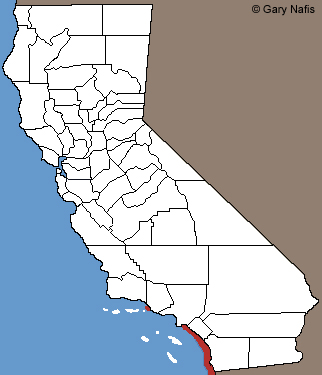|
Venomous and Potentially Dangerous!
 |
| Adult, Costa Rica © Dick Bartlett |
 |
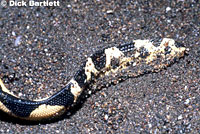 |
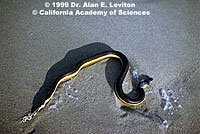 |
| |
Adult, Costa Rica © Dick Bartlett |
Adult, Puerto Vallarta, Mexico
© Dr. Alan E. Leviton
|
 |
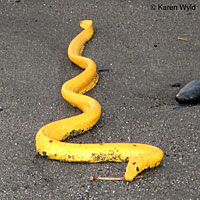 |
This snake was found on a beach in Zihuatanejo Bay, Guerrero, Mexico.
© John Orrell |
A "xanthic" snake from Playa Zancudo, on the Pacific coast of Costa Rica.
© Karen Wyld |
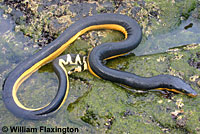 |
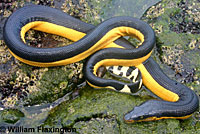 |
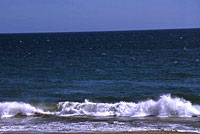 |
| Adult, Playa Ocotall, Guanacaste, Costa Rica. © William Flaxington |
Adult, Playa Ocotall, Guanacaste, Costa Rica. © William Flaxington |
Habitat, Pacific Ocean |
| |
|
|
The Environmental organization Heal the Bay has published this Facebook Information asking
anybody who finds this seasnake in California to contact somebody and report it to iNaturalist.org. |
|
|
|
|
Description |
Dangerously Venomous
A bite from this snake can cause death or serious illness or injury in humans that may require immediate medical care.
(Commonly called a "poisonous" snake to indicate that its bite is dangerous, but that is not correct. It should be called a "venomous" snake. A poisonous snake can harm you if you eat it. A venomous snake can harm you if it bites you.)
Not considered a threat to swimmers. Most bites occur when someone encounters a snake in a fishing net.
Small fangs are fixed in the jaws at the front of the mouth, so the snake needs to bite and chew to inject its venom.
|
| Size |
10 - 45 inches in length (25 - 114 cm.) Most snakes seen in the eastern Pacific are 18 - 25 inches long (46 - 64 cm.)
|
| Appearance |
A marine serpent with a narrow elongated flattened triangular head with nostrils set high on the top.
The body is flattened and the tail even more so to facilitate swimming.
There are small fangs on the front of the upper jaw. |
| Color and Pattern |
Dark brown or black with a bright yellow or pale yellow underside which extends up the sides.
Sometimes the underside is darker, sometimes a snake is all yellow or yellow with a narrow black stripe on the back.
The tail is marked with black spots or bars.
|
| Life History and Behavior |
Activity |
Diurnal and primarily aquatic, living out its entire life cycle at sea. It never needs to rest on land or on the sea floor, and rarely do so unless a snake is sick or injured and drifts ashore.
Undulates the flattened tail and body side to side in order to swim and dive.
It is able to swim backwards and forwards, but is unable to move efficiently when washed on shore.
This snake is capable of spending up to three hours underwater without surfacing and studies estimate it spends up to 87 per cent of its life underwater, surfacing mainly when the seas are calm.
An alert snake, it may dive when approached, but often it shows no concern when confronted while it is floating at the surface and can be easily captured with a net.
Not known to be very aggressive, usually reluctant to strike, and often strikes without injecting venom.
In order to remove foreign items from its body such as algae, barnacles, or other growths acquired by a life at sea, this snake ties a knot in its body and runs the knot from one end of the body to the other, cleaning the skin in the process. This technique is also used when shedding skin.
Injects deadly venom through non-movable hollow fangs located at the front of the mouth to immobilize its prey.
Typically not very aggressive towards humans, striking rarely, and often not injecting venom, but envenomation can be deadly. |
| Diet and Feeding |
Eats small surface-dwelling fish and eels.
An ambush predator, it sits and waits quietly at the surface waiting for fish to swim by.
It is thought that seasnakes get all the water they need by drinking and filtering sea water using internal salt glands and excreting the salt, but a study of captive sea kraits near Taiwan done in 2008 by Harvey Lillywhite found that those seasnakes would only drink fresh water or heavily diluted sea water. The snakes would dehydrate if they only drank sea water. Seasnakes that live near land can drink freshwater that flows into the sea from creeks or springs. Seasnakes that live in the open ocean probably drink fresh water that sits on top of sea water during and after rains. The need for fresh water might explain the worldwide distribution of seasnakes which are most common in warm areas where there is abundant rainfall. (Science Daily, 11/9/08)
|
| Reproduction |
Probably mates only in areas of water as warm as 68 degrees F (20 C) or warmer.
Large congregations of snakes have been found which were thought to be breeding congregations.
Females are ovoviviparous, bearing live young after a gestation period of around 6 months.
1 - 8 young are born in the ocean, or mangrove swamps or rocky tidal areas near shore, possibly throughout the year.
|
| Habitat |
Warm ocean waters. Usually seen within a few miles of the shore, but also occurs far out to sea. More common along drift lines with floating debris occurring where ocean currents converge creating quiet waters. These slicks attract fish providing an abundant food source for the snakes. In Central America, drift lines containing hundreds or more snakes are regularly observed.
|
| Geographical Range |
This snake is considered the most widely-distributed snake in the world, inhabiting tropical ocean waters in the Indian and Pacific Oceans, including the coasts of Africa, Asia, Australia, Mexico, including Baja California, and Central America. It is absent from the entire Atlantic Ocean because it has not been able to disperse west of Cape Horn in southern Africa. The water there is too cold for it to survive long enough for the snakes move north into warmer water. Also, there is not enough rainfall in the area to support them. Seasnakes need to drink fresh water which they get from rainwater that floats on top of salt water after a storm.
Hydrophis platurus found in California
Seasnakes are rarely seen in California. The first confirmed sighting was in 1972. They tend to be found north of their typical range in California waters mostly during El Niño years when ocean water temperatures rise several degrees above their average which allows marine animals normally found farther south to survive in California waters. However, an increasing number of sightings of seasnakes in California may be caused by the general rise in ocean temperatures and may indicate that the species is expanding its range northward. Ernst (1992)
says about P. platurus: "On occasion they may be blown or drift to the extremes of their range in the eastern Pacific, and this is most likely how they rarely reach southern California."
Most snakes found on the beach are weak and sick and pose little threat to humans. According to a 1/11/18 Orange County Register article, Greg Pauly of the Natural History Museum of Los Angeles "... said there have been no reported human fatalities as a result of the seasnake’s venom." Even so, it is still unwise to get close to them or try to handle them.
(Climate and El Niño information shown below is from the National Weather Service.)
I have found records of five Yellow-bellied Seasnakes that can be confirmed as found in California either by museum records or reputable sources:
1. San Clemente, Orange County, November 23, 1972 (LACM museum record).
1972-1973 was a strong El Niño winter.
This snake was documented in 1983, a year which has been mistakenly associated with the year the snake was found.
2. A live seasnake was found on a beach in Oxnard, Ventura County, October 15, 2015. After it died it was collected and will be deposited in the Natural History Museum of Los Angeles County.
2015-2016 was a strong El Niño winter.
Ventura County Star 10/15
KTLA 10/16/15
3.
A dead 27-inch long seasnake was found on December 12th at a Surfrider Foundation coastal cleanup event at Bolsa Chica State Beach. The snake was collected and will be deposited in the Natural History Museum of Los Angeles County.
2015-2016 was a strong El Niño winter.
KTLA 12/19/15
LA Times 12/19/15
Los Alamitos-Seal Beach Patch 12/20/15
4. A live seasnake was found at about 2:30 p.m. on Dog Beach in Coronado, San Diego County, on January 12th, 2016, making it the third one found during the 2015-2016 El Niño winter. The snake died shortly after capture. It has been described as being 20 inches in length. It will be put in the collection of the Scripps Institution of Oceanography.
LA Times 1/13/16
NBC San Diego 1/12/16
NY Daily News 1/14/16
5. A live but weak and sick 25 inch long female seasnake was found by a person walking along the surf near the 18th Street lifeguard tower in Newport Beach, Orange County, on Monday, January 8th, 2018. This sighting is unusual in that it did not occur during an El Niño winter. The snake will go on display at the Natural History Museum of Los Angeles County.
LA Times 1/11/18
Orange County Register 1/11/18
CBS Los Angeles 1/11/18
I cannot yet confirm the existence of another snake that is described as found in the San Diego area. This report might refer to the San Clemente report from 1972 which is not far north of San Diego.
References to a snake found on San Clemente Island appear to be in error and probably refer to the snake found on San Clemente beach in 1972.
There may be more sight records that have not been published or represented by a museum specimen.
If I find more confirmed sightings I will add them here.
References in Literature
"On 23 November 1972, a live adult P. platurus was discovered stranded on the beach at San Clemente, Orange County (lat 33*25'). Andrew J. Reich, a lifeguard, took custody of the snake and placed it in a salt water aquarium where it survived for 12 hours. The specimen was frozen shortly after death and borrowed 6 days later by Pickwell for examination and preservation. It was returned to the collector, who ultimately deposited it in the herpetological collections of the Natural History Museum of Los Angeles County (LACM 109657). This is the first seasnake collected in the continental United States.
The specimen is a female with a shout-vent length of 660 mm, tail length of 79 mm, tricolor pattern, dark venter, narrow lateral yellow stripe, eggs present in oviduct, substantial fat deposits, and no ectoparasites.
Mean sea surface temperature at San Clemente for 23 November 19172 was 16.1 degrees C, and for the month of November 15.5 degrees C, with a range of daily means of 15.6 to 17.8 degrees C."
Pickwell, G. V., R. L. Bezy, and J. E. Fitch. 1983. Northern occurrances of the seasnake, Hydrophis platurus, in the eastern Pacific, with a record of predation on the species. California Fish and Game 69:172-177.
Carl H. Ernst, in Venomous Reptiles of North America, 1992 writes this about Pelamis (Hydrophis) in California (p.42):
"It is the only seasnake to have reached the Hawaiian Islands, and waifs have been collected at San Clemente, Orange County, California (*Pickwell et al. 1983) and Los Angeles Bay (Shaw, 1961) and seen in the San Diego area (Stebbins, 1985). See Hecht et al. (1974)** for a detailed discussion of the distribution of Hydrophis. He says later (p.44) that "...Pickwell et al. (1983) found a dying Pelamis on a southern California beach after the water temperature had dropped to 16 degrees C. [60.8 degrees F.] ... The optimal temperature range for Pelamis seems to be 28-32 degrees C." [82.4-89.6 degrees F.]
-- The 1961 record is not from California, it is a 1960 observation from Bahia de Los Angeles (Bay of LA) in Baja California.
** Hecht, M. K., C. Kropach, and B. M. Hecht. 1974. Distribution of the yellow-bellied seasnake Pelamis platurus, and its significance in relation to the fossil record. Herpetologica 30:387-396.
Online news articles about the Oxnard
snake found in 10/15 mention that a seasnake was found in the early 1980's, citing Heal The Bay, or some say a snake was found in 1983. These are probably referencing the Pickwell record shown above, which is actually a specimen from 1972 that was written about in 1983.
In his 1985 and 2003 field guides, Stebbins writes that this species "Occasionally reaches the San Diego area of s. Calif. and has been reported off the coast as far north as San Clemente, Orange Co."
In their 2012 California field guide, Stebbins and McGinnis write about the range of this species only that: "It has been reported off the southern California coast as far north as San Clemente in Orange County."
Lemm, 2006, Field Guide to Amphibians and Reptiles of the San Diego Region, in describing this species, writes "Stragglers have been found as far north as San Clemente Island on the California coast. this species appears to enter California's waters during El Niño events, when San Diego's water temperatures increase."
|
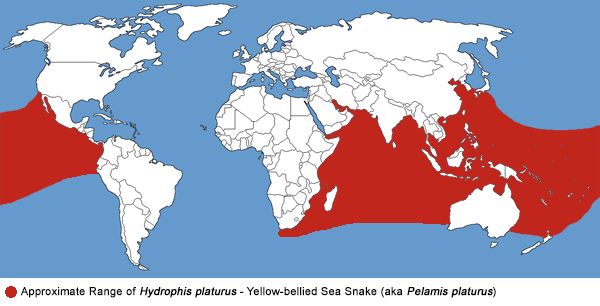 |
| Notes on Taxonomy |
"A recent study (Sanders et al., 2013, Mol. Phylogenet. Evol. 66: 575–591) corrected the long-noted non-monophyly of most seasnake genera (including Pelamis) by recognizing a single large genus Hydrophis, including H. platurus."
(SSAR Herpetological Circular No. 43, 2017)
--------------------------------------------------------------------------------------------------------------------------------------------------------------------
Hydrophis - Circum-tropical Seasnakes
"The English name was changed to differentiate from the family group name, and there are other sea snake genera. Authority corrected from “Latreille ex Sonnini and Latreille, 1801” in prior editions of this list."
(Nicholson, K. E. (ed.). 2025 SSAR Scientific and Standard English Names List)
--------------------------------------------------------------------------------------------------------------------------------------------------------------------
"Bessesen and Galbreath (2017, ZooKeys 686: 109–123) described a localized subspecies of H. platurus in Costa Rica that differs from the nominate race in size, coloration, locality, and habits. The nominate race occurs in the U.S."
(Nicholson, K. E. (ed.). 2025 SSAR Scientific and Standard English Names List)
--------------------------------------------------------------------------------------------------------------------------------------------------------------------
Alternate and Previous Names (Synonyms)
Hydrophis platurus platurus - Common Yellow-bellied Sea Snake (Nicholson, K. E. (ed.). 2025 SSAR Scientific and Standard English Names List)
Formerly called Pelamis platura, the species name was changed to the feminine platurus to match the feminine Pelamis.
Also called Pelamis platurus (Linnaeus, 1766)
Yellowbelly Sea Snake
Pelagic Sea Snaike
|
| Conservation Issues (Conservation Status) |
| None |
|
| Taxonomy |
| Family |
Hydrophiinae |
Seasnakes |
Fitzinger, 1843 |
| Genus |
Hydrophis |
Circum-tropical Seasnakes |
Latreille ex Sonnini and Latreille, 1801 |
Species
|
platurus |
Yellow-bellied Seasnake |
(Linnaeus, 1766) |
|
Original Description |
Hydrophis platurus - (Linnaeus, 1766) - Syst. Nat., 12th ed., p. 391
from Original Description Citations for the Reptiles and Amphibians of North America © Ellin Beltz
|
|
Meaning of the Scientific Name |
Hydrophis - Greek = tunny fish - presumably refers to the habitat or what Daudin thought they ate
platurus - Greek - platys- = flat + oura = tail - refers to the flattened tail
from Scientific and Common Names of the Reptiles and Amphibians of North America - Explained © Ellin Beltz
|
|
Related or Similar California Snakes |
None
|
|
More Information and References |
California Department of Fish and Wildlife
University of Michigan
Hansen, Robert W. and Shedd, Jackson D. California Amphibians and Reptiles. (Princeton Field Guides.) Princeton University Press, 2025.
Stebbins, Robert C., and McGinnis, Samuel M. Field Guide to Amphibians and Reptiles of California: Revised Edition (California Natural History Guides) University of California Press, 2012.
Stebbins, Robert C. California Amphibians and Reptiles. The University of California Press, 1972.
Flaxington, William C. Amphibians and Reptiles of California: Field Observations, Distribution, and Natural History. Fieldnotes Press, Anaheim, California, 2021.
Nicholson, K. E. (ed.). 2025. Scientific and Standard English Names of Amphibians and Reptiles of North America North of Mexico, with Comments Regarding Confidence in Our Understanding. Ninth Edition. Society for the Study of Amphibians and Reptiles. [SSAR] 87pp.
Samuel M. McGinnis and Robert C. Stebbins. Peterson Field Guide to Western Reptiles & Amphibians. 4th Edition. Houghton Mifflin Harcourt Publishing Company, 2018.
Stebbins, Robert C. A Field Guide to Western Reptiles and Amphibians. 3rd Edition. Houghton Mifflin Company, 2003.
Behler, John L., and F. Wayne King. The Audubon Society Field Guide to North American Reptiles and Amphibians. Alfred A. Knopf, 1992.
Robert Powell, Roger Conant, and Joseph T. Collins. Peterson Field Guide to Reptiles and Amphibians of Eastern and Central North America. Fourth Edition. Houghton Mifflin Harcourt, 2016.
Powell, Robert., Joseph T. Collins, and Errol D. Hooper Jr. A Key to Amphibians and Reptiles of the Continental United States and Canada. The University Press of Kansas, 1998.
Bartlett, R. D. & Patricia P. Bartlett. Guide and Reference to the Snakes of Western North America (North of Mexico) and Hawaii. University Press of Florida, 2009.
Bartlett, R. D. & Alan Tennant. Snakes of North America - Western Region. Gulf Publishing Co., 2000.
Brown, Philip R. A Field Guide to Snakes of California. Gulf Publishing Co., 1997.
Ernst, Carl H., Evelyn M. Ernst, & Robert M. Corker. Snakes of the United States and Canada. Smithsonian Institution Press, 2003.
Taylor, Emily. California Snakes and How to Find Them. Heyday, Berkeley, California. 2024.
Wright, Albert Hazen & Anna Allen Wright. Handbook of Snakes of the United States and Canada. Cornell University Press, 1957.
Ernst, Carl. H. Venomous Reptiles of North America. Smithsonian Institution Press, 1992.
|
|
|
The following conservation status listings for this animal are taken from the July 2025 State of California Special Animals List and the July 2025 Federally Listed Endangered and Threatened Animals of California list (unless indicated otherwise below.) Both lists are produced by multiple agencies every year, and sometimes more than once per year, so the conservation status listing information found below might not be from the most recent lists, but they don't change a great deal from year to year.. To make sure you are seeing the most recent listings, go to this California Department of Fish and Wildlife web page where you can search for and download both lists:
https://www.wildlife.ca.gov/Data/CNDDB/Plants-and-Animals.
A detailed explanation of the meaning of the status listing symbols can be found at the beginning of the two lists. For quick reference, I have included them on my Special Status Information page.
If no status is listed here, the animal is not included on either list. This most likely indicates that there are no serious conservation concerns for the animal. To find out more about an animal's status you can also go to the NatureServe and IUCN websites to check their rankings.
Check the current California Department of Fish and Wildlife sport fishing regulations to find out if this animal can be legally pursued and handled or collected with possession of a current fishing license. You can also look at the summary of the sport fishing regulations as they apply only to reptiles and amphibians that has been made for this website.
This snake is not included on the Special Animals List, which indicates that there are no significant conservation concerns for it in California.
|
| Organization |
Status Listing |
Notes |
| NatureServe Global Ranking |
|
|
| NatureServe State Ranking |
|
|
| U.S. Endangered Species Act (ESA) |
None |
|
| California Endangered Species Act (CESA) |
None |
|
| California Department of Fish and Wildlife |
None |
|
| Bureau of Land Management |
None |
|
| USDA Forest Service |
None |
|
| IUCN |
|
|
|
|










